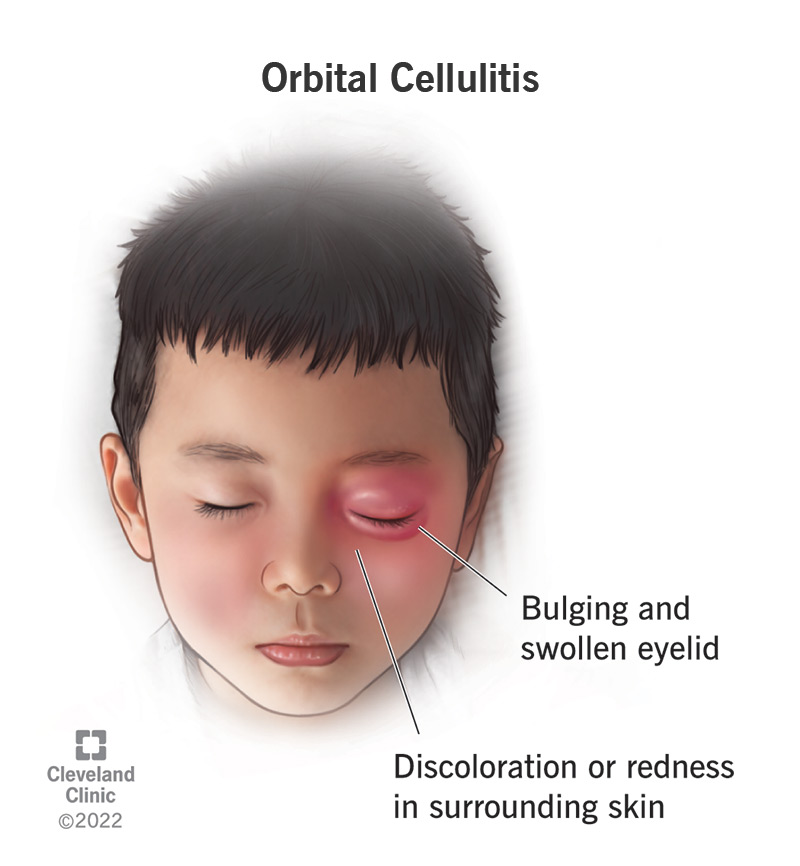Orbital cellulitis is a bacterial infection of the skin, fat and muscles around your eye. It can cause serious complications for your eye, including vision loss. Visit an eye care specialist if you notice signs of inflammation around your eye that extends beyond the eyelids. Getting treatment right away can help prevent long-term damage.
Advertisement
Cleveland Clinic is a non-profit academic medical center. Advertising on our site helps support our mission. We do not endorse non-Cleveland Clinic products or services. Policy

Orbital cellulitis is a bacterial infection in the soft tissues that surround your eye, inside of your eye socket (your orbit). It causes pain, discoloration and swelling from your eyebrow to your cheekbone. It may make your eye bulge outward. You may also have a fever. This condition most often affects children under 7 and is very serious. Go to the emergency room if your child develops these symptoms.
Advertisement
Cleveland Clinic is a non-profit academic medical center. Advertising on our site helps support our mission. We do not endorse non-Cleveland Clinic products or services. Policy
Cellulitis affects the deeper layers of your skin and the tissues beneath it, including fat and muscles. It doesn’t infect your eye, but it can threaten your vision by damaging the nerves and blood vessels around it. It can also potentially spread to your brain or bloodstream through these vessels. This could lead to life-threatening complications. Getting treatment right away can help prevent these outcomes.
Orbital cellulitis symptoms may include:
Bacteria that infect the soft tissues in your eye socket cause orbital cellulitis. Usually, infections spread from your paranasal sinuses, which run along the sides of your nose. Your ethmoid sinus is the one closest to your eye socket, and only a paper-thin membrane separates them. Most orbital cellulitis infections come from ethmoid sinus infections. They’re often staph infections or pneumococcal disease.
Infections can also come from:
Advertisement
Orbital cellulitis can be vision-threatening and life-threatening.
Vision loss and possible blindness can occur if inflammation and swelling damage your optic nerve or interrupt the blood flow to parts of your eye. Swelling can also paralyze your eye muscles so you can’t move your eye. This can cause eye misalignment and double vision.
An orbital cellulitis infection can become life-threatening if it spreads to the membrane around your brain (meningitis) or to your cavernous sinus, where it could cause a blood clot in your brain. If the infection spreads to your bloodstream, it could lead to sepsis, though this is rare.
An eye care specialist can diagnose orbital cellulitis with a physical exam. They’ll ask about your child’s symptoms, then examine the affected eye and the area around it. They’ll check their vision. Tell your provider if your child has had any recent injuries or surgery around their eye, or any recent illnesses.
Your provider might order imaging tests, like a CT scan or MRI, to see the tissues in more detail and to look for causes or complications. Sometimes, they’ll order a bacterial culture test to identify the type of infection. This isn’t always needed, but it can help providers decide which medicine to prescribe.
Healthcare providers treat orbital cellulitis with intravenous (IV) antibiotics. This means your child will stay in the hospital and receive medicine through a catheter into their vein. This is the quickest way to deliver the medicine throughout their body. When your child’s symptoms start to improve, usually after a few days, they can go home and switch to oral antibiotics (pills). They’ll take these for a few weeks.
Rarely, your child might need a procedure to treat complications of orbital cellulitis, like to:
Call or visit an eye care specialist as soon as you notice orbital cellulitis symptoms around your child’s eye. It’s very serious, but getting it treated right away can prevent long-term damage. Call your healthcare provider if your child has an infection that isn’t getting better or might be spreading. Let the provider know if they’re taking antibiotics and their symptoms haven’t improved after a few days.
You might want to ask:
Advertisement
In most cases, you can expect a full recovery from orbital cellulitis. The sooner your child gets treatment, the less likely it is that they’ll have any lasting complications. They might need to take antibiotics for several weeks before the infection goes away completely. It’s important that they take the full course of antibiotics prescribed, even if they’re feeling better. This ensures the infection won’t come back.
You can prevent orbital cellulitis by treating infections as soon as possible, especially if they’re close to your eyes. Many common infections that are normally less serious than orbital cellulitis can become more serious if they spread. Treating these infections immediately can prevent them from spreading.
Orbital cellulitis usually starts from common and less serious infections. If you’re a parent or caregiver of a young child, you might be shocked by how fast an infection like this can turn into an emergency. This is a scary moment for both of you. But if you act fast, you can expect a full recovery without long-term damage. Call a provider right away if you notice your child has developed swelling all around their eye.
Advertisement
Cleveland Clinic’s ophthalmologists and optometrists have the highest training available. We provide exams, vision correction and care for many eye conditions.

Last reviewed on 04/02/2025.
Learn more about the Health Library and our editorial process.